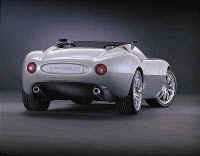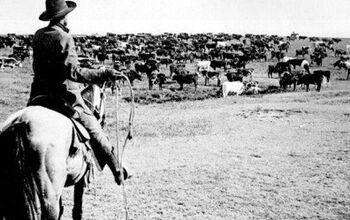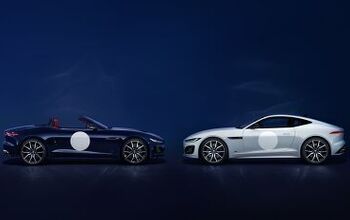F Off!
Britain entered WWII an economic powerhouse, a major player on the world stage, the master of a vast colonial empire. She emerged bloodied, battered and broke. The Empire was going, going, gone. Industry struggled with the transition from a war to a peacetime economy. Rationing continued. In 1948, into this fug of austerity, Jaguar launched the XK120. The impossibly glamorous two-seater combined world-beating performance with everyday practicality and sublime comfort. The XK120 marked the end of one era, and the beginning of another. It made Jaguar rich, and millions of people proud to be British.
In the early sixties, Britain was on its uppers. The Winter of Discontent was no more than a chill breeze. The turgid class system was alive and well, but cracks were beginning to appear. Teenage culture was in first flower. One year into this new decade, Jaguar launched another car that tapped into and distilled the national gestalt: the E-Type Series I. The E-Type was a sensationally sexy, supremely capable automobile that a great many "average" enthusiasts could afford. As the Austin Powers movies demonstrate (ad nauseum), the E-Type embodied all that was fun and funky about the era. The car re-invigorated Jaguar, and made millions of people proud to be British.
And then… what? The E-Type died of obesity. The Mk2 marked start of Jaguar's foray into mechanically dubious "fat blokes" cars, culminating in the 1970's era XJ12 luxobarge. Fortunately, when the big Jags weren't languishing in the repair shop, they managed to live up to their founder's ideal of "grace and pace". Unfortunately, the company's attempts to make a credible sports car weren't. Browns Lane had turned its back on high performance motoring. The factory-sponsored racing programme, an effort that had sealed the XK and E-Type's reputation, was a distant memory. The leaping cat had become a lounge lizard.
Thanks to years of mismanagement, poor build quality, crap dealers and a dull product range; Jaguar found itself unable to fend off Ford's attentions. Under the Blue Oval, the XJ saloon lost its digital dash, regained its sensuous curves and added reliability. Die-hard fans of the marque eagerly awaited the first all-new, Ford-sponsored Jag: the XK8. Would Jaguar finally be true to its pedigree and build a genuine sports car? No. The XK8 was big, bold and beautiful. It was also expensive, overweight and ungainly.
Then we had the S-Type, a less than aesthetically delightful move sideways from the XJ. Next up: the X-Type, a timid, cynical move downwards ("Premium" Automotive Group indeed). But there was still hope that Ford-owned Jaguar hadn't lost sight of its roots: the F-Type.
The F-Type had a real shot at putting Jaguar back on top. The car was due to feature a mid-mounted V6. In supercharged form, the engine would have pumped out 330bhp. An aluminium chassis clad with steel panels would have delivered a devastating power-to-weight ratio. Independent coil-sprung suspension on all four corners would have given the F-Type sufficient poise for a bit of Boxster-bashing. Throw in a gorgeous shape, reliability, a decent boot and a decent sticker price, and the F-Type could have been the car of the noughts. It certainly would have made enthusiasts proud to be British.
Alas, no. Ford spiked the F-Type. The bean counters decided that shovelling diesel engines into the XJ, S-Type and X-Type, and transforming the X-Type into a Labrador lugger, is a better investment than building a new, affordable sports car. Porsche, the world's most profitable carmaker (per vehicle), sells some 28,000 Boxsters per year. Yet Ford couldn't see the "business case" for building a car that would sell in similar volumes. Are these the same accountants who decided it's OK for Jaguar to piss-away the equivalent of Belize's GNP on Formula One?
Killing the F-Type is a shocking miscalculation. The X-Type's raison d'etre— reflected by their "new generation" ads— was to bring younger customers to the marque. In reality, the X-Type is a scaled down replica of the XJ that appeals to middle-aged customers who can't afford the real thing. Compared to the F-Type, the X-Type has about as much youthful appeal as a Hollywood star on her fourth facelift. In the battle for the hearts and dimes of tomorrow's drivers, well, let's put it this way: you won't see a poster of an X-Type on the bedroom walls of a teenage enthusiast. The F-Type would have had pride of place next to Britney, Jordan and David.
When Ford gobbled-up Jaguar, both companies dismissed claims that Jaguar had lost its independence. Executives swore on their expense accounts that Ford would simply extend Jaguar's ability to follow its own, uniquely British automotive destiny. Ford would respect Jaguar's traditions of craftsmanship, engineering innovation and pedal-to-the-metal excitement. Now we know the truth. And it makes me ashamed to be American.
More by Robert Farago
Latest Car Reviews
Read moreLatest Product Reviews
Read moreRecent Comments
- SCE to AUX Range only matters if you need more of it - just like towing capacity in trucks.I have a short-range EV and still manage to put 1000 miles/month on it, because the car is perfectly suited to my use case.There is no such thing as one-size-fits all with vehicles.
- Doug brockman There will be many many people living in apartments without dedicated charging facilities in future who will need personal vehicles to get to work and school and for whom mass transit will be an annoying inconvenience
- Jeff Self driving cars are not ready for prime time.
- Lichtronamo Watch as the non-us based automakers shift more production to Mexico in the future.
- 28-Cars-Later " Electrek recently dug around in Tesla’s online parts catalog and found that the windshield costs a whopping $1,900 to replace.To be fair, that’s around what a Mercedes S-Class or Rivian windshield costs, but the Tesla’s glass is unique because of its shape. It’s also worth noting that most insurance plans have glass replacement options that can make the repair a low- or zero-cost issue. "Now I understand why my insurance is so high despite no claims for years and about 7,500 annual miles between three cars.



































Comments
Join the conversation
[...] clear that Jaguar would not be building the achingly gorgeous sub-XK roadster (a decision that Robert Farago called “a shocking miscalculation.” But now, with mules already prowling the British countryside, a new baby Jag roadster [...]